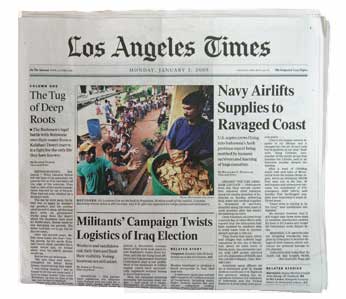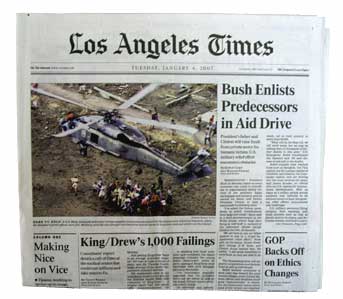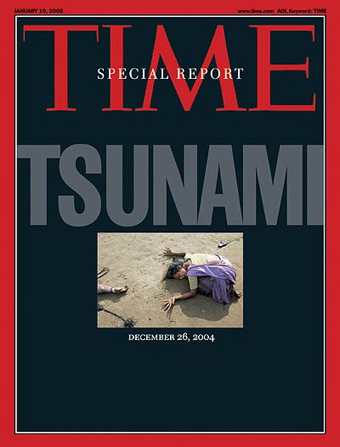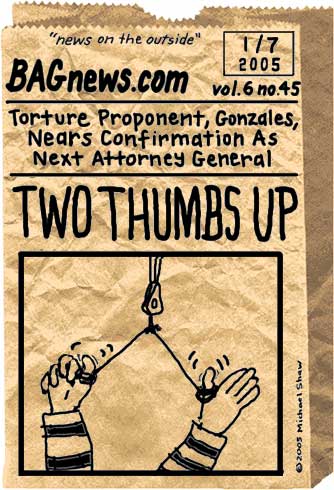Notes
The Events of December 26th, 2004
If you’d have asked me Monday morning (exactly one week after) where this tidal wave story was headed, I would have probably voted for obscurity.
How come?
Because the Christmas holiday — typically a dormant news period — was ending; the President had already "caught up" with the disaster (having committed substantial funds, troops and material); the "mandate emboldened" conservative Congress would be back in session the next day (ready to "end social security as we know it"); the Palestinian election was just a week off; the crucial Iraqi election was fast approaching (while the insurgency was reaching new heights); the media was notorious for attention deficit; the story seemed to bring up too many uncomfortable questions about why we weren’t doing more about African AIDS, the Congo or Darfur; the effort would require uncomfortably close cooperation between the U.S. and the U.N.; and, probably most indicative (at least to me — being on the pictorial beat), was the fact that Monday’s lead photo of the disaster in the LA Times, which had been running four or even five columns wide throughout the crisis, had suddenly dropped to three.

What I didn’t expect, however, was that the story would dominate Monday’s news. And dominate the attention of the incoming Senators and Congressmen. And that, on Tuesday, when I checked the Times, the lead photo would be four columns again.

(Which is where it has remained, in both the LA and NYTimes, throughout this second week.)
I want to go back to Monday, though. Despite the buzz, I still saw the story as problematic for semantic reasons. What I mean is, it involved 11 countries; various political and religious systems; two separate catastrophes of nature; victims from dozens of nations — and nobody had a clear way to refer to it. Tuesday, however, was a whole new story.

By Tuesday evening, even Charlie Rose was waving this magazine around. As well he should. The issue not only named the crisis, it turned it into a brand.
(What I’m also interested in — but will mostly leave for another post — is the relationship between this disaster and 9/11. I think this cover not only references 9/11, but designates the tidal wave as it’s "successor.")
But let’s stick to the job at hand. First, consider the large text. Just as 9/11 went through various descriptions in its immediate aftermath (such as, "The events of September 11th, 2001"; "The attack on the Pentagon and the World Trade Center"; and, simply, "The terror attacks"), so did the tidal wave. MSNBC described it as "The South Asian earthquake and tsunami." the Time website initially referred to it as the "Sea of Sorrow."
To acquire stature and permanence, however, the events of December 26th, 2004 had to have a name. Of course, it was not like the world had never seen a tsunami before. Therefore, this tsunami would become the one by which all others would be known. But, instead of labeling it "THE TSUNAMI," the magazine executed a grammatical maneuver, eliminating the "THE." By omitting the article (just as one would refer to "Prince" or "Madonna"), they created a formal name.
Having established the name (or "brand"), the next step was to establish monumentality. This was achieved by juxtaposing the smaller photo with the larger title (or logo). The message conveyed is that the scale of the event (represented symbolically by the letters) was/is actually larger than the reality (represented by visual evidence of the suffering, and the untold number of victims).
The scale is further reinforced by the layout. The fact that the letter "T" (on the left), and the "I" (on the right) run up against the border suggests that the TSUNAMI was (and remains) so large, it cannot be put in context. The fact the "TSUNAMI" title relates so strongly to the "TIME" logo also hints at comparison. Because the "TSUNAMI" text is larger (or, at least, bolder and wider) than the name of the magazine, there is the suggestion that the event (like all things historical) must exist "beyond time."
(Edited for overexuberance — 1/10/05)


Reactions
Comments Powered by Disqus